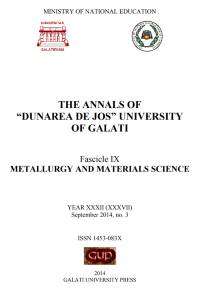Establishing the Rolling - Friction Coefficient for Different Contacts Between Balls and Termochemicallly Treated Steel Rolling Paths
Abstract
Within the frame of this work, the influence of four very well-known and often used thermochemical treatments (carburizing, carbonitriding, nitriding and nitrocarburizing) of steel rolling paths applied on rolling-friction coefficient has been studied. The rolling - friction tests supposed different arrangements of the semi-couples (plates) and intermediary balls. Because of the difficulty in estimating the value (dimension) of the rolling friction coefficient, an equivalent static friction coefficient μ0 (at the start) was established for all the couples. According to the experimental results of this study, the carburized rolling paths seemed to offer the best conditions for rolling, the initial move appearing at the earliest. In addition, the presence of nitrogen and the possible FexN compounds on the contact rolling surface leads to an increased friction coefficient μ0. Finally, the study demonstrated that there is a slight tendency for a certain decrease in μ0 when increasing the intermediary balls diameter.
Downloads
References
[2]. Pavelescu D., Tribotechnics, Bucharest: Technical Publishing House, 1983.
[3]. Pavelescu D., Tudor A. - Tribology, Bucharest: Pedagogical and Didactical Publishing House, 1980.
[4]. ***, http://steel.keytometals.com/articles.
[5]. Munts V. A., Baskatov A. P. - Rate of carburizing of steel, Metal Science and Heat Treatment (English Translation of Metallovedenie I TermicheskayaObrabotkaMetalov), 1983, 25, p. 98-102.
[6]. Moiseev B. A., Brunzel Y. M., Shvartsman L. A. - Kinetics of carburizing in an endothermal atmosphere, Metal Science and Heat Treatment, (English Translation ofMetallovedenie I TermicheskayaObrabotkaMetalov), 1979, 21, p. 437-442.
[7]. Totten G. E., Howes M. A. H. - Steel Heat Treatment, Handbook, NewYork: Marcell Dekker Inc., 1997.
[8]. Surface Hardening of Steel, ASM International. Materials Park. Ohio, 2002.
[9]. ASM Handbook. ASM International. Materials Park. Ohio, 1991.
[10]. Slycke J., Ericsson T. - A study of reactions occurring during the carbonitring process, Journal of Heat Treating, 1981, 2, p. 3-19.
[11]. Slycke J., Ericsson T. - A study of reactions occurring during the carbonitring process, Part II. Journal of Heat Treating, 1981, 2, p. 97-112.
[12]. Pye D. - Practical nitriding and ferriticnitrocarburizing, ASM International, Materials Park, Ohio, 2003.
[13]. Somers M. A. J., Mittemeijer E. J. - Layer-grow kinetics on gaseous nitriding of pure iron: Evaluation of diffusion coefficients for nitrogen in iron nitrides, Metallurgical and Materials Transactions A, 1995, 26, p. 57-74.
[14]. Somers M. A. J., Mittemeijer E. J. - Modeling the kinetics of the nitriding and nitrocarburizing of iron, Heat Treating 1997, Proceedings of the 17th Conference ASM International, 1998, p. 321-330.
[15]. Maldzinski L., Liliental W., Tymowski G., Tacikowski J. - New possibilities for controlling gas nitriding process by simulation of growth kinetics of nitride layers, Surface Engineering, 1999, p. 15:377-384.
[16]. Sola R., Giovanardi R., Veronesi P., Poli G. - Improvement of wear and corrosion resistance of ferrous alloys by post – nitrocarburizing treatments, Metalurgical Science and Technology, 2011, 29-2, p. 14-24.
[17]. Bobancu S., Cozma R., Cioc V. - Tribology and Inventics - Practical Applications, Brasov, Transilvania University Publishing House, 2000.
[18]. Cozma R., Bobancu S., Cioc V. - Equipment and devices for tribological characterizations, Bucuresti, Matrix Rom, 2005.
[19]. Munteanu D., Vaz F. - Tribological researches on rolling – friction coefficient for carburized and carbonitrided steel surfaces, Journal of the mechanical behavior of materials, 2005, 16, p. 407-418.
[20]. Somers M. A. J. - Thermodynamics, kinetics and microstructural evolution of the compound layer; a comparison of the states of knowledge of nitriding and nitrocarburizing, Heat Treatment of Metals, 2000, 4, p. 92-102.
[21]. Du H., Somers M. A. J., Agren J. - Microstructural and compositional evolution of compound layers during gaseous nitrocarburizing, Metallurgical and Materials Transactions A, 2000, 31, p. 195-211.
[22]. Qiang Y. H., GE S. R., Xue Q. J. - Microstructure and tribological behaviour of nitrocarburizing - quenching duplex treated steel, Tribology International, 1999, 32, p. 131–136.
[23]. Xiao L., Bjorklund S., Rosen B. G. - The influence of surface roughness and the contact pressure distribution on friction in rolling/sliding contacts, Tribology International, 2007, 40, p. 694–698.



